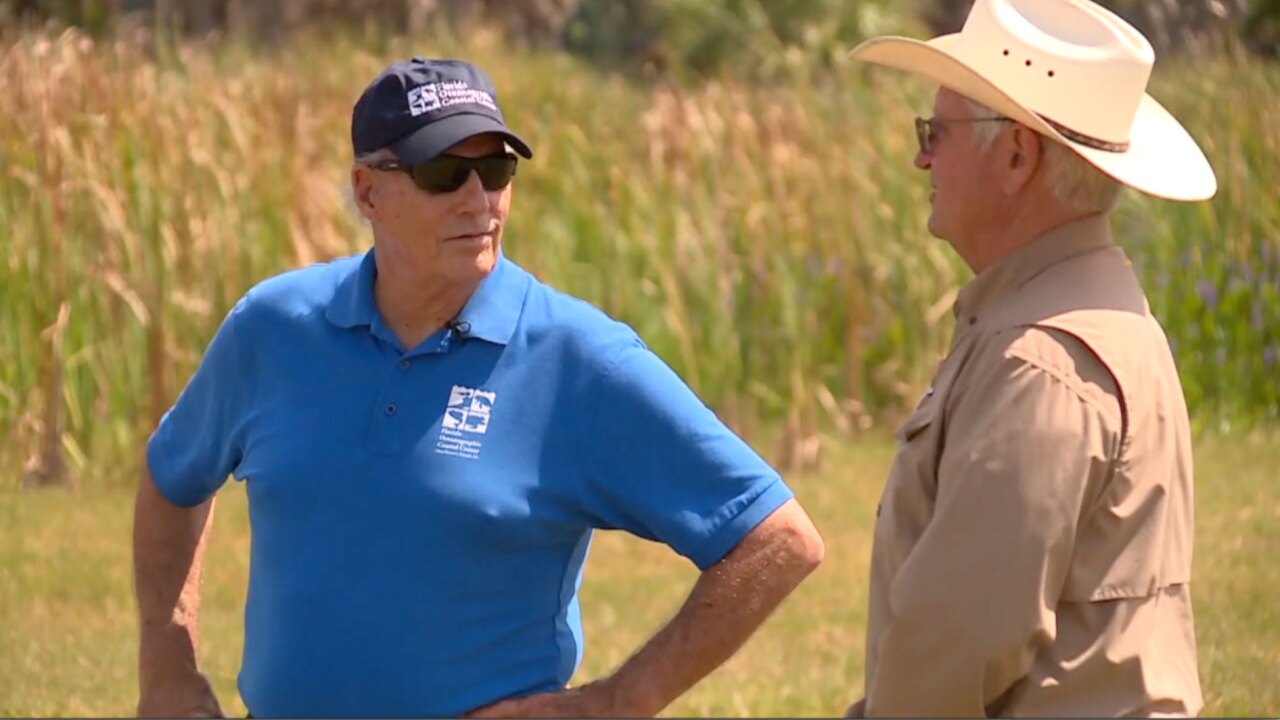OKEECHOBEE COUNTY, Fla. — Algal blooms that have often crippled the Treasure Coast over the years can in part be traced to fertilizer runoff from ranches and farms north of Lake Okeechobee. That pollution later ends up in the lake.
But ranchers are working to be a part of the solution to help reduce a problem that has affected South Florida for years.
Wes Williamson said his family has been ranching and raising beef cattle in Okeechobee County for 76 years.
The more than 10,000-acre Williamson Cattle Company is located just 6 miles north of Lake Okeechobee.
It's been a way of life that started with his grandfather and then to Williamson's 93-year-old father, Sonny and now down to his son, daughter and extended family.

Williamson gave WPTV anchor Michael Williams and Mark Perry, the executive director and CEO of the Florida Oceanographic Society, an up-close understanding of the stewardship of his family's land.
Feeding several thousand beef cattle on his ranch means using phosphorous-rich fertilizer for pastureland.
"This ranch we do a phosphorous budget," Williamson said. "We measure how much phosphorous we bring in, which is basically a little bit of fertilizer and some feed."
The Florida Department of Agriculture outlines best management practices, and Williamson said those are part of his routine to-do list.
"Something as important as phosphorous to a grass, you're going to go do a soil test," Williamson said.
He lets the soil tell him whether he needs more fertilizer or can limit its use at any given time.
"I have the same concerns and goals, as I think, anyone over on the coast or anywhere in the state of Florida," Williamson said. "We're concerned about our environmental footprint. We all should be."

He explained where the biggest part of reducing that footprint from his ranch can be found.
"At this edge of the wetland, we may be 5 miles from Lake Okeechobee, and so it's important to kind of just retain, slow up the water here, store the water here," Williamson explained.
Water storage north of Lake Okeechobee is vital to controlling fertilizer runoff and restoring wetlands.
Williamson sold a 2,500-acre conservation easement on part of his ranch in 2010, which was part of a federally-funded wetland reserve program.
"That was a win-win on a couple of fronts," WPTV anchor Michael Williams said to Williamson.
"Absolutely .... in the summertime during the wet season, August and September, this will be a solid sheet of water out here," Williamson said.
Runoff from his ranch in Okeechobee County goes into nearby Taylor Creek, which then runs into Lake Okeechobee.

Storing that water as long as possible allows phosphorous and nitrogen — which supercharge algal blooms — to settle into the soil, feed the pasture and fatten the cattle.
"They're doing it right," Perry said. "They're conserving the land. They're conserving the water."
"More water that can be held on the land, the less phosphorous and nitrogen end up in Lake Okeechobee and therefore the less on the coastline," WPTV anchor Michael Williams said.
"That's correct because we know what feeds algal blooms in the lake and other lakes is the overloading of nutrients," Perry said.
Ranchers and environmentalists think more conservation easements north of Lake Okeechobee are key.
"That allows a ranch not to be broken up, cut up and going into what dad always called the 'final crop,' and that's housing," Williamson said. "It's happening out here in Okeechobee."
It is about fighting for a way of life and the health of the environment, on which the ranch's long-term future depends.
"I want to preserve this for future generations, not just future generations of Williamsons, but future generations of Floridians," Williamson said. "We've got to preserve some of these ranchlands out here, and the tremendous environmental character that they have."




